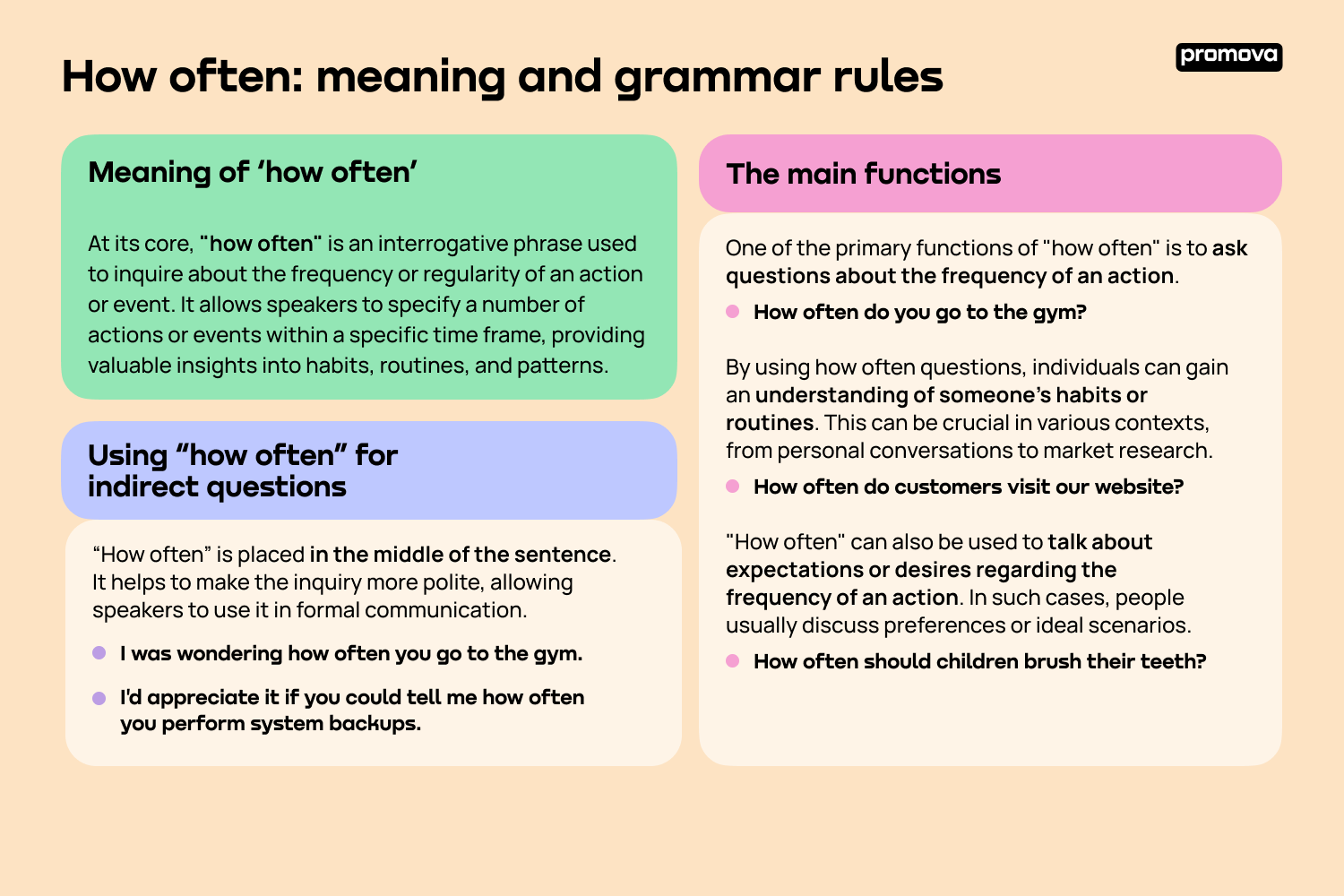How often: meaning and grammar rules
Contents
The phrase "how often" seems quite simple, but it holds a significant role and function in English communication, allowing speakers and writers to inquire about frequency, habits, and routines. In this guide, you will explore the nuances of using "how often," uncover its various functions and get clear rules to help use it effectively in your writing and conversations.
Meaning of how often
At its core, "how often" is an interrogative phrase used to inquire about the frequency or regularity of an action or event. It allows speakers to specify a number of actions or events within a specific time frame, providing valuable insights into habits, routines, and patterns.
The main functions of how often
One of the primary functions of "how often" is to ask questions about the frequency of an action. For example:
- How often do you go to the gym?
- How often does it rain in this region?
By using how often questions, individuals can gain an understanding of someone’s habits or routines. This can be crucial in various contexts, from personal conversations to market research. For instance:
- How often do you check your email?
- How often do customers visit our website?
"How often" can also be used to talk about expectations or desires regarding the frequency of an action. In such cases, people usually discuss preferences or ideal scenarios. Here are some examples for better understanding:
- How often would you like me to provide updates?
- How often should children brush their teeth?
The phrase "how often" is a powerful tool in English communication. Whether used in casual conversations, market research, setting expectations, or other situations, mastering the use of "how often" enhances clarity and facilitates effective communication across various contexts. By understanding its functions, you can speak precisely and convey your ideas with clarity.
Rules for using how often
In interrogative sentences, "how often" typically precedes the auxiliary or main verb if there is no auxiliary. Here is an example:
- Incorrect: Do how often you exercise?
- Incorrect: How exercise often do you?
- Correct: How often do you exercise?
In answering ‘how often’ questions, it’s essential to specify the time frame to ensure clarity. This can include time expressions such as "every day," "once a week," "monthly," or specific time intervals. For example:
- Question: How often do you go jogging?
- Answer: I go jogging every week.
- Question: How often do you visit your parents?
- Answer: We visit our parents monthly.
The tense used in the question should match the action's occurrence. If asking about a habit or general frequency, the present simple is used. For past actions, the past tense is appropriate.
- Present: How often do you go to the gym?
- Past: How often did you go to the library last year?
You can also form negative questions with "how often" to inquire about the lack of frequency. For instance:
- How often don’t you wake up early?
- How often don’t you eat breakfast?
This structure, though less common, can be useful in certain contexts but may require careful intonation to maintain clarity.
5
Using how often for indirect questions
Indirect questions are not asked directly to the listener but are embedded within another statement or question. They typically do not follow the standard question format and do not end with a question mark when written. Indirect questions are a softer, less direct way of asking something, often used in formal settings or when the speaker wishes to be especially courteous. You can identify them when sentences start with such phrases as:
- I wonder…;
- I would like to know…;
- I'm curious to know…;
- I'd like to find out…;
- I'm interested to learn…;
- It would be helpful to know…
The sentence structure of indirect questions with “how often” differs from direct ones. In such cases, “how often” is placed in the middle of the sentence. It helps to make the inquiry more polite, allowing speakers to use it in formal communication. Here are some examples:
- I was wondering how often you go to the gym.
- I'd appreciate it if you could tell me how often you perform system backups.
- I'm seeking advice on how often it's advisable to review and update a personal budget.
Using "how often" in indirect questions is a valuable skill in English communication. It enables you to make inquiries about frequency in a respectful and culturally sensitive way.

Conclusion
‘How often’ is a very important phrase for surveys, research, discussing habits, routines, etc. People use it daily in all spheres of life, from healthcare to customer service. By understanding its role, function, and rules, you can confidently engage both in casual conversations and formal meetings.



Comments